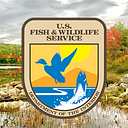Lessons learned and put to the test at Rhode Island refuge
When Hurricane Sandy hit the Rhode Island coast in late October 2012, Sachuest Point National Wildlife Refuge got hammered. Five years later to the day, the remnants of Tropical Storm Philippe struck New England, bringing strong winds and heavy rain. This time, the refuge was ready, thanks to work by the U. S. Fish and Wildlife Service and its partners.
The Wrath of Sandy
Hurricane Sandy brought heavy rain, wind gusts exceeding 80 miles per hour, and a storm surge boosted by a full moon to Sachuest Point. It wrought havoc on the refuge, chewing up pavement, strewing rocks and chunks of concrete onto the access road, and knocking down power poles. Maidford Marsh was flooded and its outlet to the Sakonnet River blocked by sand.
Restoring power to the visitor center took three months and re-opening the road another three, at a cost of $648 thousand. Thousands of would-be visitors were inconvenienced.
Fortifying Infrastructure
Following Sandy, the Service worked with partners to repair and armor the access road, bury 7,000 feet of utility lines that run alongside it, and remove 60 utility poles. The work cost more than $1 million and was supported by Federal funding for Hurricane Sandy recovery and resilience projects and a generous $250,000 donation from local partners.
Mending the Marsh
The northern end of the marsh at Sachuest Point was modified dramatically in the early 20th century, when the Maidford River was rerouted and the Connector Road built from one side to the other. The southern end served as the dump for the Town of Middletown until 2004, when trash was removed and placed in a landfill to the west of the marsh.
With the marsh’s natural water movement, or hydrology, altered, the northern end was prone to flooding during heavy rain storms. After Sandy, it was inundated for an extended period, and the Connector Road was underwater.
In 2015, as part of another project supported by Hurricane Sandy funds, refuge staff created new channels in the marsh to improve its hydrology and drain storm water. When they realized more were needed, they contracted with the Woods Hole Group, in East Falmouth, Massachusetts, to study further the hydrology of the marsh. Another channel was added this fall, and staff will continue to assess the situation.
With support from a Hurricane Sandy Resilience grant from the National Fish and Wildlife Foundation, the Town of Middletown, Rhode Island, raised the Connector Road through the marsh to reduce its chances of being overtopped by floodwaters.
A Trial Run
This year’s storm was the result of bombogenesis, which happens when air pressure drops rapidly, intensifying the winds at the center of the storm. While not a hurricane, it brought heavy rain, high winds, and more power outages than Sandy. Due to the moon phase, tides were lower, reducing storm surge.
This time, there was no flooding and no loss of power at the refuge. The access road and visitor center remained open to the public. Cleanup amounted to closing lids on trash bins.
In the northern Maidford Marsh, stormwater drained through new channels and into the Sakonnet River without backing up. The Connector Road remained above water and open to traffic.
“We were hoping that the new channels would improve drainage, and this storm demonstrated that they have,” said Dr. Jennifer White, the Service’s Hurricane Sandy resiliency coordinator.
A #StrongerCoast
It’s hard to make a direct comparison between last month’s storm and Hurricane Sandy, but the conditions presented by the two are strikingly similar. While Sachuest Point experienced high winds and heavy rain during both, the damage to infrastructure and habitat was like night and day.
Knocked to its knees five years ago, the refuge returned stronger, meeting the recent challenge head-on and remaining up and running for wildlife and people.

